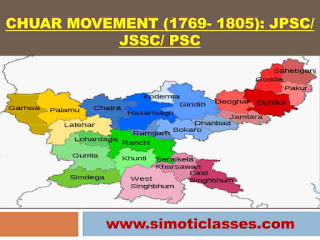Kol Movement (1831-32)
Causes and nature of rebellion:
The Kol rebellion has a special place in the tribal revolts in Jharkhand, because it was the first organized and widespread tribal revolt of Jharkhand. Exploited by their new masters, oppressed by dikus (outsiders), and deprived of their traditional source of justice, the tribals of Chotanagpur had no choice but to revolt. In fact, it was a rebellion of the Mundas, in which Ho joined as his right hand.
The tribes of some areas of Chotanagpur Khas, Palamu, Singhbhum, and Manbhum participated in this rebellion. Only Hazaribagh remained untouched by this rebellion. It was the result of the Kol rebellion that in 1834 AD, an administrative unit named 'South-West Frontier Agency' (SWFA) was formed by merging the revolt-affected areas with some of the other areas, with its headquarters at Vishunpur or Wilkinsonganj (later Ranchi) created.
Key facts of Kol rebellion (for MCQ):
- If anyone bothered the British rulers and landlords the most in Chotanagpur, it was the Kol rebels.
- In this rebellion, the tribes of Chotanagpur, especially Palamu, Singhbhum, and other parts of the Manbhum actively participated.
- The main reason for the Kol rebellion was 'land dissatisfaction'.
- One of the main leaders of this rebellion was Budhu Bhagat. In this battle, he was killed along with his brother, son, and 100 followers.
- The revolt was suppressed, but the lands of the village headman (Munda) and their peed chief (Mankis) made up of seven to twelve were returned.
- As a result of this rebellion, a new province Southwest Frontier Agency was formed in 1833 AD. Later, financial and judicial powers were also given to the 'Manki Munda System'.



































